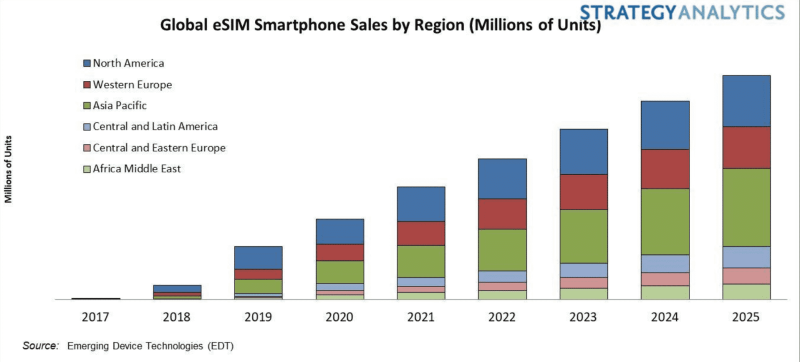Optus Flex raises the eSIM bar
Optus just took the lead in the eSIM race with their Optus Flex plan, which allows customers to sign up for an eSIM plan through the My Optus app.
Compare this to Telstra’s and TPG Telecom/Vodafone’s eSIM plans, which require a QR code to be mailed to customers by post, after which the customer would have to scan the QR code to activate the eSIM plan.
With Optus’ latest move, new customers with eSIM devices can easily switch to an Optus plan on-the-go. This was a significant selling point for eSIM technology in the early stages, but has only come into reality with Optus’ latest announcement.
In this post, we’ll tell you all about the eSIM market, Optus Flex, and eSIM plans in Australia.
What is an eSIM and where can I get one?
An eSIM is essentially an embedded SIM – that is, rather than having a separate, physical SIM card for every telco you purchase a plan from, an eSIM is built into your device itself and activates your SIM plan digitally.
eSIM technology launched in Australia back in 2017. However, eSIM devices were mostly wearables and tablets back then.
Now, though, you can find a wide selection of eSIM-enabled smartphones in the Australian market as the technology trends upwards. Here’s a look at some of the popular eSIM phones available in Australia today:
- iPhone XS through 12 series
- Samsung Galaxy S20 through S21 series, Galaxy Fold, Galaxy Z Flip
- Pixel 3 through 5 series
- Huawei P40, P40 Pro
You’ll find these eSIM-enabled smartphones and more, from the major telcos (Telstra, Optus, and TPG Telecom/Vodafone) as well as online and retail shops and manufacturers. And with manufacturers launching newer models of flagship phones every year, you can expect even more eSIM phones.
The eSIM trend isn’t limited to Australia either – it is global. According to research by Strategy Analytics, in 2019, eSIM-enabled smartphones accounted for under 20 percent of all smartphones shipped in Western Europe. Predictions for the following year, 2020, ballooned to 32 percent, when 39 million eSIM-enabled smartphones were expected to be shipped to the region.
That’s close to a 50% jump year-on-year, and if that trend holds true, the vast majority of smartphones in that region will be eSIM-enabled in a year or two. This type of growth is evident in other regions as well.
Research by Strategy Analytics indicates global eSIM smartphone sales will continue. source
The key behind this growth boils down to how easy it is to purchase and activate a SIM plan in minutes with an eSIM phone. Until now, no Australian telco allowed that capability – seemingly because it would make it too easy for customers to switch telcos whenever a better deal pops up. But with Optus’ latest announcement, things have changed.
Activate Optus Flex plan in minutes through My Optus on eSIM phone
Being able to activate a SIM plan without waiting for a SIM card to come in the post, or walking in to a store to purchase a SIM card, is the beauty of the eSIM. Optus has made that a reality by allowing customers to activate eSIM plans via My Optus, but there are some limitations.
For now, you can only activate Optus prepaid plans through My Optus. SIM Only postpaid plans don’t have that capability yet, so if you’re looking for a postpaid eSIM plan, you would have to wait for a QR code to come in the post, and then scan that code to activate your postpaid plan.
Optus Flex consists of 3 prepaid plans that all add up to $1 per GB per day – ranging from a daily plan that gives you 1GB per day for $1 per day, to a 30GB monthly plan. To get started, purchase an Optus SIM for $1, then download the My Optus app on your eSIM smartphone, log in, and activate your Optus Flex plan. The process lasts just a matter of minutes.
Other eSIM plans in Australia
You can get an eSIM plan from Telstra and TPG Telecom/Vodafone as well. However, activating your plan from those telcos will require scanning a QR code that is sent to you by post. This isn’t much different than receiving a physical SIM card by post, except that their eSIM plans are activated without having to install a physical SIM card.
For now, no MVNO in Australia offers eSIM plans. For this to change, the major telcos that wholesale their networks to MVNOs would have to open up the technology to them as well. The ACCC has expressed concern over telcos keeping MVNOs in the dark, so there’s a good chance eSIM technology might soon be available to smaller telcos.
In fact, while Optus and TPG Telecom/Vodafone have been silent on the matter, Telstra announced that telcos on their network would get access to eSIM plans in the coming months.
Final words
Optus’ move here is substantial and almost certainly caused by the proportion of phone companies like Samsung and Apple who include eSIMs in their devices. This will create more competition and make it much easier to change phone companies.
However, Optus remains silent on whether MVNOs reselling their network will be able to resell eSIM plans anytime soon. But with Telstra announcing their intention to open up eSIM plans to MVNOs, perhaps Optus will follow suit soon enough. It might be the time to start comparing your next SIM plan options.
